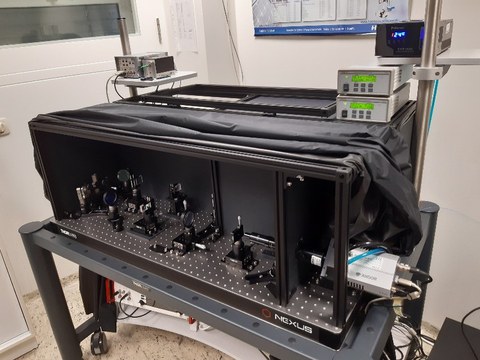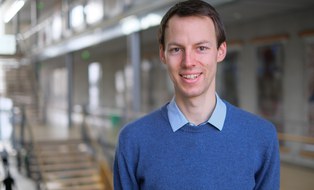Combined Brillouin and Raman spectroscopy
When light interacts with tissue, inelastic scattering processes occur in addition to elastic Rayleigh scattering. During these processes, energy of light quanta (photons) is exchanged with vibrational quanta (phonons). This interaction can be exploited to obtain contact-free, non-invasive and non-destructive information about biological tissue.
The two spectroscopic methods differ in the type of phonons with which the photons interact. In the case of Raman spectroscopy, these are optical phonons that provide information about the chemical bonds and thus the biochemistry of the sample. In the case of Brillouin spectroscopy, the interaction takes place with acoustic phonons, which are associated with sound propagation and provide information about the biomechanical properties of the sample.
The combination of the two optical methods in one measurement system is possible because the basic setup of the two scattering experiments is similar. Only for the

Instrumental setup of the combined Brillouin-Raman system
detection two different spectrometers are used, since the Brillouin-scattered photons, in contrast to the Raman-scattered photons, have a wavelength shift of only a fraction of a nanometer. Apparatively, so-called virtually imaged phased arrays (VIPA) are used for this purpose. A simultaneous and co-localized acquisition of Brillouin and Raman spectra allows to link biochemical information directly to biomechanical properties.
This method is used, for example, in tumor research. It is used to investigate the biomechanical and biochemical properties of tumor cells. Precise knowledge of their properties, especially in processes such as proliferation, invasion and metastasis, helps to find appropriate targets for novel therapeutic approaches. This opens up new treatment options for tumor types for which there are currently no satisfactory therapies, such as glioblastomas.

Combined raster measurement of a tumor cell (left: bright-field image), showing the nucleolus with the highest Brillouin shift (stiffness) in the Brillouin map (center). Clustering of the Raman spectra (right) confirms that the nucleus (blue) is located in this region.
Contact
 © Julia Walther
© Julia Walther
Mr Dr. rer. nat. Jan Rix M.Sc.
Send encrypted email via the SecureMail portal (for TUD external users only).
Arbeitsbereich Medizinische Physik und Biomedizinische Technik
Arbeitsbereich Medizinische Physik und Biomedizinische Technik
Visiting address:
Medizinisch-Theoretisches Zentrum (MTZ - Haus 91) Fiedlerstraße 42
01307 Dresden
